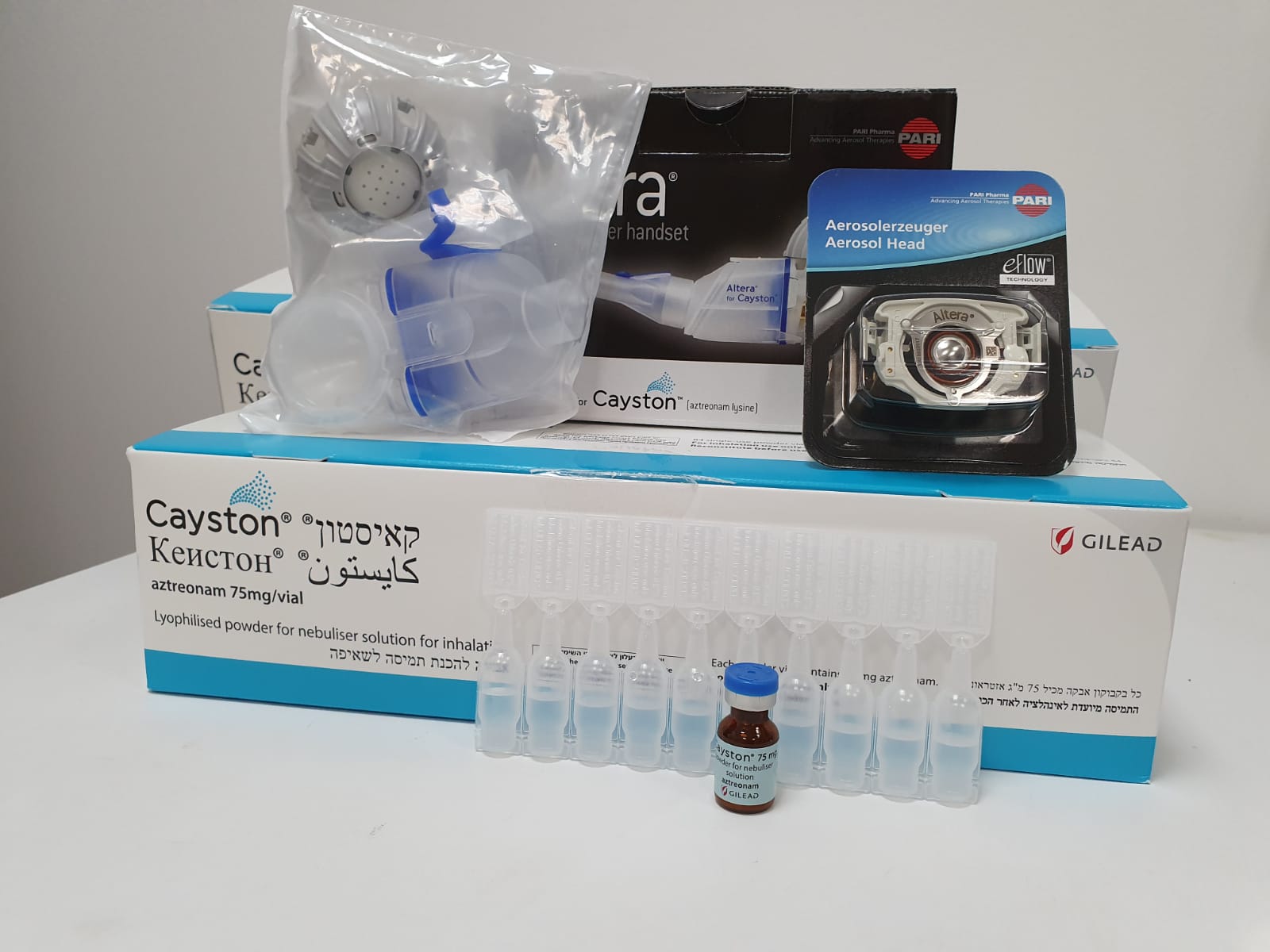Quest for the right Drug

קאיסטון CAYSTON (AZTREONAM)
תרופה במרשם
תרופה בסל
נרקוטיקה
ציטוטוקסיקה
צורת מתן:
שאיפה : INHALATION
צורת מינון:
אבקה מיובשת בהקפאה לתמיסת נבולייזר : LYOPHILIZED POWDER FOR NEBULISER SOLUTION
עלון לרופא
מינוניםPosology התוויות
Indications תופעות לוואי
Adverse reactions התוויות נגד
Contraindications אינטראקציות
Interactions מינון יתר
Overdose הריון/הנקה
Pregnancy & Lactation אוכלוסיות מיוחדות
Special populations תכונות פרמקולוגיות
Pharmacological properties מידע רוקחי
Pharmaceutical particulars אזהרת שימוש
Special Warning עלון לרופא
Physicians Leaflet
Special Warning : אזהרת שימוש
4.4 Special warnings and precautions for use Allergic reactions If an allergic reaction to aztreonam does occur, stop administration of the medicinal product and initiate treatment as appropriate. The occurrence of rash may be indicative of an allergic reaction to aztreonam. Cross-reactivity may occur in patients with a history of allergy to beta-lactam antibiotics, such as penicillins, cephalosporins, and/or carbapenems. Animal and human data demonstrate low risk of cross-reactivity between aztreonam and beta-lactam antibiotics. Aztreonam, a monobactam, is only weakly immunogenic. Caution is advised when administering Cayston to patients if they have a history of beta-lactam allergy. The following rare and severe adverse reactions have been reported after parenteral use of other aztreonam containing products: toxic epidermal necrolysis, anaphylaxis, purpura, erythema multiforme, exfoliative dermatitis, urticaria, petechiae, pruritus, diaphoresis. Bronchospasm Bronchospasm (an acute reduction of ≥ 15% in FEV1) is a complication associated with nebulised therapies. Bronchospasm has been reported after Cayston administration (see section 4.8). Patients should use a bronchodilator before each dose of Cayston. If a case of bronchospasm is suspected to be part of an allergic reaction appropriate measures should be taken (see “allergic reactions” paragraph above). Haemoptysis Inhalation of nebulised solutions may induce a cough reflex. The use of Cayston in paediatric CF patients has been associated with haemoptysis during treatment cycles and could have aggravated underlying conditions. Administration of Cayston in CF patients with active haemoptysis should be undertaken only if the benefits of treatment are considered to outweigh the risks of inducing further haemorrhage. Other precautions Efficacy has not been established in patients with FEV1 > 75% predicted. Patients with Burkholderia cepacia isolated from sputum within the previous 2 years were excluded from the clinical studies. Aztreonam for injection must not be used in the Altera or other nebulisers. Aztreonam for injection has not been formulated for inhalation, and contains arginine, a substance known to cause pulmonary inflammation. Resistance to aztreonam, other antibiotics and treatment-emergent microorganisms The development of antibiotic-resistant P. aeruginosa and superinfection with other pathogens represent potential risks associated with antibiotic therapy. Development of resistance during inhaled aztreonam therapy could limit treatment options during acute exacerbations. A decrease in P. aeruginosa susceptibility to aztreonam and other beta-lactam antibiotics was observed in clinical studies of Cayston. In a 24-week active-controlled clinical study of Cayston therapy, increases were observed in the MIC90 for all P. aeruginosa isolates as well as in the percentages of patients with P. aeruginosa resistant (MIC above the parenteral breakpoint) to aztreonam, to at least 1 beta-lactam antibiotic, and to all 6 beta-lactam antibiotics tested (see section 5.1). However, decreased P. aeruginosa susceptibility was not predictive of clinical efficacy of Cayston during the study. Among patients with multidrug-resistant P. aeruginosa, improvements in respiratory symptoms and pulmonary function were observed following treatment with Cayston. The emergence of parenteral P. aeruginosa resistance to aztreonam or other beta-lactam antibiotics may have potential consequences for the treatment of acute pulmonary exacerbations with systemic antibiotics. An increased prevalence of methicillin-resistant Staphylococcus aureus (MRSA), methicillin-sensitive S. aureus (MSSA), Aspergillus and Candida species was observed over time in patients treated with several Cayston treatment courses. An association between persistent isolation of MRSA and worse clinical outcome has been reported in the literature. During clinical studies of Cayston, isolation of MRSA did not result in worsening of lung function.
Effects on Driving
4.7 Effects on ability to drive and use machines Cayston has no or negligible influence on the ability to drive or use machines.

פרטי מסגרת הכללה בסל
1. התרופה האמורה תינתן לטיפול נגד פסאודומונס ארוגינוזה בחולי לייפת כיסתית, שמיצו את הטיפול ב-Tobramycin.2. התרופה האמורה לא תינתן במקביל לטיפול ב-Tobramycin באינהלציה, למעט בחולים עם תפקודי ריאה מתחת ל-40%.
מסגרת הכללה בסל
התוויות הכלולות במסגרת הסל
| התוויה | תאריך הכללה | תחום קליני | Class Effect | מצב מחלה |
|---|---|---|---|---|
| התרופה האמורה תינתן לטיפול נגד פסאודומונס ארוגינוזה בחולי לייפת כיסתית, שמיצו את הטיפול ב-Tobramycin. | 12/01/2014 |
שימוש לפי פנקס קופ''ח כללית 1994
לא צוין
תאריך הכללה מקורי בסל
12/01/2014
הגבלות
תרופה מוגבלת לרישום ע'י רופא מומחה או הגבלה אחרת
מידע נוסף
